Pathogenic Shiga toxin-producing Escherichia coli in the intestine of calves
- PMID: 11989736
- PMCID: PMC226985
Pathogenic Shiga toxin-producing Escherichia coli in the intestine of calves
Abstract
The purpose of this study was to compare the pathological effects of Shiga toxin-producing Escherichia coli (STEC) that vary in their association with bovine and human disease. Shiga toxin-producing E. coli of serotypes associated with both dysentery in calves and hemolytic uremic syndrome (HUS) in humans (O5:H-, O26:H11, O111:H-,O113:H21) were compared with O157:H7 STEC, which are associated with HUS in humans but not with disease in calves. The STEC were administered orally to 80 day-old chicks and into ligated loops in the ileum and colon of four 2- to 6-day-old calves. Examination of the ceca of the chickens 10 d postchallenge showed no adherence or tissue abnormality for any isolate. The calves were euthanized 8 to 10 h postinoculation, and sections of the intestinal loops were examined by light microscopy, transmission and scanning electron microscopy, and immunohistochemistry. All strains showed consistent focal adherence associated with mild lesions in the colon. Attaching and effacing lesions were observed with the eae-positive strains. Ileal lesions were similar to the colonic ones but were sometimes severe, with marked polymorphonuclear leukocyte proliferation in the lamina propria. It is concluded that chickens were unsuitable for studying interaction of STEC with the intestine and that there was no difference in the interaction of the ligated calf intestine with STEC of serotypes associated with disease in calves compared with O157:H7 STEC.
Figures
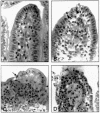
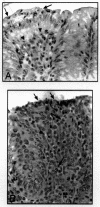
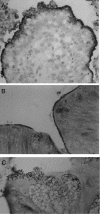
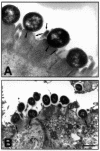
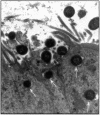
Similar articles
-
Serotypes, virulence genes, and intimin types of Shiga toxin-producing Escherichia coli (STEC) and enteropathogenic E. coli (EPEC) isolated from calves in São Paulo, Brazil.Int J Food Microbiol. 2007 Apr 20;115(3):297-306. doi: 10.1016/j.ijfoodmicro.2006.10.046. Epub 2007 Jan 12. Int J Food Microbiol. 2007. PMID: 17292501
-
Antimicrobial resistance of Shiga toxin (verotoxin)-producing Escherichia coli O157:H7 and non-O157 strains isolated from humans, cattle, sheep and food in Spain.Res Microbiol. 2005 Aug;156(7):793-806. doi: 10.1016/j.resmic.2005.03.006. Epub 2005 Apr 22. Res Microbiol. 2005. PMID: 15921895
-
Production of attaching-effacing lesions in ligated large intestine loops of 6-month-old sheep by Escherichia coli O157:1H7.J Med Microbiol. 2002 Sep;51(9):755-763. doi: 10.1099/0022-1317-51-9-755. J Med Microbiol. 2002. PMID: 12358066
-
Prevalence and pathogenicity of Shiga toxin-producing Escherichia coli in beef cattle and their products.J Anim Sci. 2007 Mar;85(13 Suppl):E63-72. doi: 10.2527/jas.2006-421. Epub 2006 Oct 23. J Anim Sci. 2007. PMID: 17060419 Review.
-
Shiga toxin-producing Escherichia coli: an overview.J Anim Sci. 2007 Mar;85(13 Suppl):E45-62. doi: 10.2527/jas.2006-508. Epub 2006 Nov 3. J Anim Sci. 2007. PMID: 17085726 Review.
Cited by
-
Colonization, persistence, and tissue tropism of Escherichia coli O26 in conventionally reared weaned lambs.Appl Environ Microbiol. 2007 Feb;73(3):691-8. doi: 10.1128/AEM.01879-06. Epub 2006 Dec 8. Appl Environ Microbiol. 2007. PMID: 17158624 Free PMC article.
-
Metagenomic analysis of human, animal, and environmental samples identifies potential emerging pathogens, profiles antibiotic resistance genes, and reveals horizontal gene transfer dynamics.Sci Rep. 2025 Apr 9;15(1):12156. doi: 10.1038/s41598-025-90777-8. Sci Rep. 2025. PMID: 40204742 Free PMC article.
-
Virulence factors and antibiograms of Escherichia coli isolated from diarrheic calves of Egyptian cattle and water buffaloes.PLoS One. 2020 May 11;15(5):e0232890. doi: 10.1371/journal.pone.0232890. eCollection 2020. PLoS One. 2020. PMID: 32392237 Free PMC article.
-
Responses of cattle to gastrointestinal colonization by Escherichia coli O157:H7.Infect Immun. 2008 Nov;76(11):5366-72. doi: 10.1128/IAI.01223-07. Epub 2008 Sep 2. Infect Immun. 2008. PMID: 18765741 Free PMC article.
-
The neuroendocrine stress hormone norepinephrine augments Escherichia coli O157:H7-induced enteritis and adherence in a bovine ligated ileal loop model of infection.Infect Immun. 2004 Sep;72(9):5446-51. doi: 10.1128/IAI.72.9.5446-5451.2004. Infect Immun. 2004. PMID: 15322043 Free PMC article.
References
-
- Gannon VP, Gyles CL. Characteristics of the Shiga-like toxin produced by Escherichia coli associated with porcine edema disease. Vet Microbiol 1990;24:89–100. - PubMed
-
- Wray C, McLaren I, Pearson GR. Occurrence of ‘attaching and effacing’ lesions in the small intestine of calves experimentally infected with bovine isolates of verocytotoxic E. coli. Vet Rec 1989;125:365–368. - PubMed
Publication types
MeSH terms
Substances
LinkOut - more resources
Full Text Sources
Medical
